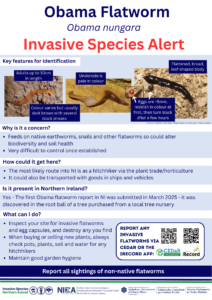Obama nungara
Obama Nungara
Overview
Overview
Photo credit: Hugh Jones, Scientific Associate, Natural History Museum, London.
Obama nungara
Habitat:
Description:
Origin and Distribution:
Impacts:
Is it found in Northern Ireland?
How could it get here?
You can help by reporting any sightings: @ the Centre for Environmental Data & Recording (CEDaR) - Or via the iRecord App.
Prevent Spread
For further queries, you can contact the Invasive Non Native Species (INNS) Team in the Northern Ireland Environment Agency on 028 9056 9558 or Email: invasivespecies@daera-ni.gov.uk
Obama nungara
Habitat:
- Around freshwater rivers, lakes and wetlands
- Areas of soft, sandy or muddy substrate
- Also found in human disturbed areas, such as parks and gardens
Description:
- 10cm in length 1cm in width
- Broad leaf-shaped body
- Dark brown with black dorsal streaks
- Colour ranges from very dark-mid brown with occasional pale midline
- Ventral side is pale
- Has many black eyes around the head and sides but are difficult to spot
- Lays 5mm cocoons which are black and take a few weeks to hatch
Origin and Distribution:
- Native to South Brazil and Argentina
- Scattered distribution in the UK
- Also found in Guernsey, Jersey, Belgium, France, Spain, Ireland, Italy, Portugal, Maderia and the Azores
- Distribution is mainly linked to climate
Impacts:
- Feeds on native earthworms, snails and other flatworms changing the biodiversity
- Hard to get rid of so can easily spread
Is it found in Northern Ireland?
- One report in Northern Ireland but they are found in Ireland
How could it get here?
- Transported with goods in ships and vehicles
- Main route of invasion is through the plant trade
You can help by reporting any sightings: @ the Centre for Environmental Data & Recording (CEDaR) - Or via the iRecord App.
Prevent Spread
- Report all sightings
- Do not bring this species into Northern Ireland
- Inspect incoming consignments of plants
- Don't accept plants from areas where the Obama flatworm is present, as this can aid their spread
- Maintain good garden hygiene
- Inspect your site for flatworms
- Destroy immediately if you detect them (see flatworm control)

For further queries, you can contact the Invasive Non Native Species (INNS) Team in the Northern Ireland Environment Agency on 028 9056 9558 or Email: invasivespecies@daera-ni.gov.uk
